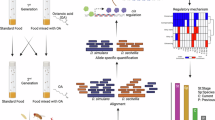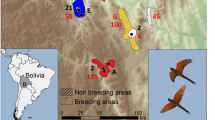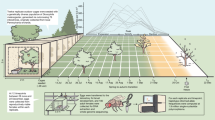Abstract
The effect of environmental heterogeneity on the genetic variation of different quantitative characters was studied in two laboratory and two recently captured populations of Drosophila melanogaster. Two different culture media (habitats R and G) were used. Coarse-grained heterogeneity with independent density control in each habitat (R + G), and fine-grained (R/G) heterogeneity were simulated in population cages. Control populations in both R and G habitats were also maintained.
Genetic differences for oviposition-site preference, larval preference and/or within-habitat viability were found between subpopulations sampled from different media. This happened in all four populations maintained on R + G, two populations maintained on R/G, and one control population. Thus, environmental heterogeneity seems to protect genetic variability responsible for between-habitat genetic differentiation, particularly when such heterogeneity corresponds to the ‘soft selection’ model (R + G). However, for the quasi-neutral trait sternopleural bristle number, no genetic between-habitat differentiation, nor increased heritability were observed in populations maintained under any kind of environmental heterogeneity. Hence, although soft selection seems to be a real force in determining adaptation to heterogeneous environments, the genetic variability maintained may be small in relation to the whole genome.
Similar content being viewed by others
Article PDF
References
Abdel Rehim, A H. 1983. Difference in habitat selection by different morphs of the land snail Arianta arbustorum. Biol J Linn Soc, 20, 185–193.
Barton, N H, Jones, J S, and Mallet, J. 1988. No barriers to speciation. Nature, 336, 13–14.
Bird, S R, and Someonoff, R. 1986. Selection for oviposition preference in Drosophila melanogaster. Gen Res, 48, 151–160.
Cavener, D. 1979. Preference for ethanol in Drosophila melanogaster associated with the Alcohol Dehydrogenase polymorphism. Behav Genet, 9, 359–365.
García-Dorado, A. 1986. The effect of niche preference on polymorphism protection in a heterogeneous environment. Evolution, 40, 936–945.
García-Dorado, A. 1987. Polymorphism from environmental heterogeneity: Some features of genetically induced niche preference. Theor Pop Biol, 32, 66–75.
García-Dorado, A. 1990. The effect of soft selection on the variability of a quantitative trait. Evolution, 44, 168–179.
Guittenberg, E. 1988. Sympatric speciation in snails: A largely neglected model. Evolution, 42, 826–828.
Haley, C S, and Birley, A J. 1983. The genetical response to natural environments. II. Observations on replicate populations in spatially varied laboratory environments. Heredity, 51, 581–606.
Hill, W G. 1970. Design of experiments to estimate heritability by regression of offspring on selected parents. Biometrics, 26, 566–571.
Hoekstra, R F, Biljsma, R, and Dolman, J. 1985. Polymorphism from environmental heterogeneity: models are only robust if the heterozygote is close in fitness to the favoured homozygote in each environment. Gen Res, 45, 299–314.
Hoffman, A. 1985. Effect of experience on oviposition and attraction in Drosophila: comparing apples and oranges. Am Nat, 126, 41–51.
Jaenike, J, and Grimaldi, D. 1983. Genetic variation for host preference within and among populations of Drosophila tripunctata. Evolution, 37, 1023–1033.
Jaenike, J. 1987. Genetics of oviposition-site preference in D. tripunctata. Heredity, 59, 363–369.
Jones, J S. 1980. Can Genes choose habitats? Nature, 286, 757.
Jones, J S. 1982. Genetic differences in individual behaviour associated with shell polymorphism in the snail Cepea nemoralis. Nature, 298, 749–750.
Jones, J S, and Probert, R F. 1980. Habitat selection maintains a deletereous allele in a heterogeneous environment. Nature, 287, 632–633.
Lerner, I M. 1954. Genetic Homeostasis. Oliver and Boyd, Edinburgh.
Levene, H. 1953. Genetic equilibrium when more than one ecological niche is available. Am Nat, 87, 331–333.
Lopez-Fanjul, C, and Ruano, R G. 1987. Indirect natural selection for bristle number induced by ‘domestication’ in populations of Drosophila melanogaster. Genét Ibér, 39, 379–388.
McDonald, J F, and Ayala, F J. 1974. Genetic response to environmental heterogeneity. Nature, 250, 572–574.
MacKay, T. 1981. Genetic variation in varying environments. Gen Res, 37, 79–93.
Maynard Smith, J. 1966. Sympatric speciation. Am Nat, 100, 637–650.
Maynard Smith, J, and Hoekstra, R. 1980. Polymorphism in varied environment: how robust the models are? Gen Res, 35, 45–57.
Minawa, A, and Birley, A J. 1978. The genetical response to natural selection by varied environments. I. Short-term observation. Heredity, 40, 39–50.
Powel, J R, and Wistrand, H. 1978. The effects of heterogeneous environments and a competitor on genetic variation in Drosophila. Am Nat, 112, 935–947.
Prout, T. 1968. Sufficient conditions for multiple niche polymorphism. Am Nat, 102, 493–496.
Rausher, M D. 1984. The evolution of habitat preference in subdivided populations. Evolution, 83, 596–608.
Rausher, M D. 1985. Variability for host preference in insect populations: Mechanistic and evolutionary models. J Insect Physiol, 31, 873–889.
Rice, W R. 1985. Disruptive selection on habitat preference and the evolution of reproductive isolation: An exploratory experiment. Evolution, 39, 645–656.
Rice, W R. 1989. Analyzing tables of statistical tests. Evolution, 43, 223–225.
Rice, W R, and Salt, G W. 1988. Speciation via disruptive selection on habitat preference: Experimental evidence. Am Nat, 131, 911–917.
Robertson, A. 1967. The nature of quantitative genetic variation. In: Brink, R. A. (ed.), Heritage from Mendel, University of Wisconsin Press, Wisconsin, USA, pp. 265–280.
Singer, M C, and Thomas, C D. 1988. Heritability of ovi-position preference and its relationship to offspring performance within a single insect population. Evolution, 42, 977–985.
Taylor, C E, and Condra, C. 1983. Resource partitioning among genotypes of D. pseudoobscura. Evolution, 37, 135–149.
Thompson, J N. 1988. Evolutionary genetics of oviposition preference in swalowtail butterflies. Evolution, 42, 1223–1234.
Verdonk, M. 1987. Adaptation to environmental heterogeneity in populations of D. melanogaster. Gen Res, 49, 1–10.
Via, S. 1986. Genetic covariance between oviposition preference and larval performance in an insect herbivore. Evolution, 40, 778–785.
Yamazaki, T, Kusakabe, S, Tachida, H, Ichinose, M, Yoshimaru, H, Matsuo, Y, and Mukay, T. 1983. Re-examination of diversifying selection of polymorphic allozyme genes by using population cages in Drosophila melanogaster. Proc Natl Acad Sci, 80, 5789–5792.
Acknowledgements
We thank A. Gallego, C. Lopez-Fanjul and M. A. Toro for helpful comments, and to an anonymous referee for careful notes which greatly improved the manuscript. This work was supported by a CICYT grant (No. PB86-0017).
Author information
Authors and Affiliations
Rights and permissions
About this article
Cite this article
García-Dorado, A., Martin, P. & García, N. Soft selection and quantitative genetic variation: a laboratory experiment. Heredity 66, 313–323 (1991). https://doi.org/10.1038/hdy.1991.40
Received:
Issue date:
DOI: https://doi.org/10.1038/hdy.1991.40
Keywords
This article is cited by
-
Host race formation in the Acari
Experimental and Applied Acarology (2007)



